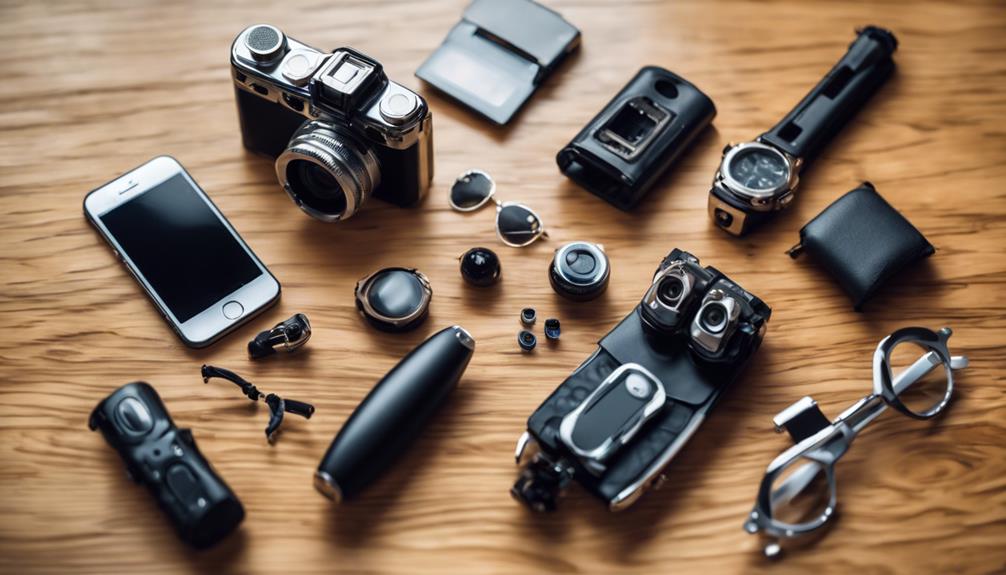
In the realm of wildlife observation and outdoor exploration, spy trail cameras have emerged as indispensable tools for nature enthusiasts, researchers, and hunters alike. These innovative devices not only capture stunning images of wildlife but also provide valuable insights into animal behavior and habitat preferences. As technology continues to advance, the benefits and functionalities of spy trail cameras are becoming more accessible, making them a must-have for anyone keen on connecting with the great outdoors. In this article, we will explore what spy trail cameras are, their key features, benefits, and how to optimize their use for nature observation.
What is a Spy Trail Camera and How Does It Work?
A spy trail camera, often referred to simply as a trail camera, is a remotely activated device designed to capture photos or videos of wildlife in their natural habitat. These cameras are typically equipped with motion sensors that detect movement, triggering the camera to take images or record video clips. Most modern models use infrared technology, allowing them to capture images even in low light conditions, such as during dawn or dusk when many animals are most active.
The operation of these cameras is relatively straightforward. After being set up in a desired location, the camera remains in standby mode until it detects motion within its range. Once triggered, it captures the specified images or videos and saves them onto an internal memory card. Many trail cameras now feature wireless connectivity, enabling users to receive real-time updates and images directly to their smartphones, making the entire observation process more efficient and engaging.
Key Features to Look for in a Spy Trail Camera
When investing in a spy trail camera, several key features should be considered to ensure you select the best model for your needs. First and foremost, image resolution is crucial. A higher megapixel count results in clearer and more detailed images, which can be vital for identifying specific wildlife species. Look for cameras that offer at least 12 MP for quality photography and videography.
Another important feature is the camera’s trigger speed and recovery time. The trigger speed refers to how quickly the camera captures an image once motion is detected, while recovery time indicates how fast the camera is ready to take another shot. A faster trigger speed ensures that fleeting moments are not missed, making it ideal for capturing quick-moving wildlife. Additionally, consider battery life, storage capacity, and weather resistance to ensure your camera performs reliably in various conditions.
Benefits of Using a Spy Trail Camera for Wildlife Observation
One of the primary benefits of using spy trail cameras is the ability to observe wildlife without disturbing their natural behavior. Unlike human observers, these cameras can blend seamlessly into the environment, allowing for authentic captures of animals in their habitats. This unobtrusive approach provides insights into animal habits, feeding patterns, and social interactions, ultimately enriching our understanding of wildlife ecology.
Furthermore, trail cameras offer a low-maintenance solution for ongoing wildlife monitoring. Once set up, they can operate independently for weeks or even months, depending on battery life and memory capacity. This means that users can gather extensive data over time, which is particularly valuable for researchers conducting long-term studies or for individuals interested in tracking specific wildlife populations in their local areas.
Capturing Stunning Wildlife Photos with Spy Trail Cameras
Spy trail cameras have the incredible ability to capture stunning, high-quality images that showcase the beauty and diversity of wildlife. With advanced features like night vision and motion detection, these cameras are capable of snapping breathtaking shots of elusive creatures, from majestic deer to fascinating nocturnal animals that are rarely seen by human eyes. The thrill of discovering unexpected wildlife through your camera’s lens can deepen your appreciation for nature.
In addition to capturing wildlife in their natural habitats, these cameras can also document seasonal changes and animal behaviors over time. For instance, you may capture images of the same family of bears returning to the same spot each year, or watch as fawns grow and learn from their mothers. The beauty of these photographs not only serves to enhance our understanding of wildlife but also provides eye-catching content for sharing with family and friends or for use in educational purposes.
How to Set Up Your Spy Trail Camera for Best Results
Proper setup is essential for maximizing the effectiveness of your spy trail camera. Start by selecting a suitable camera model with features that align with your specific goals, whether for wildlife observation, research, or hunting. Once you have your camera, find an area with signs of wildlife activity, such as tracks, scat, or feeding areas. Setting your camera about 3 to 4 feet above the ground can help optimize the angle of capture.
When positioning your camera, aim it towards trails, water sources, or feeding areas where animals frequently pass. Additionally, ensure that the camera is secured to prevent theft or damage from wildlife. Use camouflage or natural vegetation to help the camera blend into its surroundings. Finally, test the camera’s settings and perform a test run by checking the capture zone to ensure that all expected areas are covered effectively.
Choosing the Right Location for Your Spy Trail Camera
The location of your spy trail camera plays a critical role in the quality of the footage you’ll capture. Look for high-traffic areas where animals are known to roam, such as trails, feeding sites, and watering holes. Observing wildlife patterns at different times of day can also help you determine the best spots for camera placement, increasing the chances of capturing impactful images or videos.
Consider the environmental factors that may affect animal movement as well. Weather conditions, seasonal changes, and the time of year can all influence when and where wildlife is active. For example, placing your camera near a known food source during winter months, when food is scarce, can yield fruitful results. By taking the time to scout and choose optimal locations, you can significantly enhance your wildlife monitoring experience.
Tips for Maintaining Your Spy Trail Camera Long-Term
To ensure your spy trail camera remains operational and effective for the long term, regular maintenance is essential. Start by periodically checking the camera for any signs of wear or damage caused by weather, wildlife, or vandalism. Clean the lens and sensor periodically to prevent dirt or moisture buildup, which could affect image quality. Additionally, replace batteries and memory cards as needed to ensure continuous operation.
Another important aspect of maintenance is data management. Regularly download and back up your images and videos to prevent loss and to keep track of your findings over time. Many trail cameras now offer cloud storage options, making it easy to access and organize your captures. By consistently checking and maintaining your camera, you can ensure it continues to provide valuable insights into the wildlife that surrounds you.
Comparing Popular Spy Trail Camera Models on the Market
With a wide array of spy trail cameras available today, it can be challenging to choose the right one. Some popular models include the Bushnell Trophy Cam, Browning Strike Force, and Stealth Cam G42NG, each offering a unique combination of features tailored to different needs and budgets. The Bushnell Trophy Cam, for example, is known for its exceptional image quality and long battery life, making it suitable for extended monitoring sessions.
In contrast, the Browning Strike Force provides ultra-fast trigger speeds and versatile shooting modes, appealing to serious wildlife photographers and hunters alike. The Stealth Cam G42NG is recognized for its user-friendly setup and robust connectivity options, perfect for those who appreciate real-time updates. By comparing features, reviews, and prices, you can make an informed decision that aligns with your specific goals and preferences.
Real-Life Applications of Spy Trail Cameras in Research
Spy trail cameras have found numerous applications in scientific research, particularly in the fields of ecology and wildlife conservation. Researchers utilize these cameras to collect vital data on animal populations, behavior, and habitat usage without the need for intrusive observation methods. This non-invasive approach leads to more accurate research outcomes and helps in the development of effective conservation strategies.
In addition to studying animal behavior, trail cameras are also employed in monitoring endangered species and assessing the effectiveness of conservation programs. By capturing images of rare or threatened species, researchers can gather insights into their population status and movements, which can inform critical conservation efforts. The versatility and efficiency of spy trail cameras make them an invaluable asset in the ongoing quest to understand and protect our planet’s wildlife.
Why Every Nature Enthusiast Needs a Spy Trail Camera
For any nature enthusiast, a spy trail camera can significantly enhance the experience of exploring the outdoors. These cameras provide an opportunity to connect with wildlife on a deeper level, allowing users to witness the fascinating behaviors and interactions of animals that they might not otherwise see. The thrill of capturing stunning images or videos fosters a greater appreciation for the natural world and its inhabitants.
Additionally, spy trail cameras can serve as valuable educational tools. Whether you are a nature lover, a teacher, or a parent, sharing the imagery and insights gathered from these cameras can inspire others to become more engaged with wildlife and conservation efforts. By investing in a spy trail camera, you not only enrich your own outdoor experiences but also contribute to the wider community’s understanding of the importance of preserving our natural ecosystems.
In conclusion, spy trail cameras provide a wealth of opportunities for wildlife observation, research, and education. Their advanced features, ease of use, and ability to capture stunning imagery make them essential tools for nature enthusiasts and researchers alike. By carefully selecting the right camera, setting it up properly, and maintaining it over time, you can unlock the secrets of the natural world and enhance your appreciation for the incredible wildlife that surrounds us. Whether you’re an avid photographer, a dedicated researcher, or simply someone who enjoys observing nature, a spy trail camera is an investment worth making.




